We then climbed, wedged, weaved and squeezed our way though the cliff dwelling, stopping every now and then for a bit more history.
Balcony House was built in 1040. It had 38 rooms and 2 kivas. Interestingly enough, it faces east. This makes it a rather cold place since there is not much sun exposure. There is also no evidence of fire in a majority of it, so they were probably not sleeping here during the cold seasons. There was apparently also not much cooking done here. So what was it used for? Well, it had a view of the La Plata Mountains, which were considered sacred. The dwelling was also lined with a short wall along the outer edge. This contained some very interesting markings. Furthermore, a T-shaped doorway (located directly between the two kivas and in front of the seep spring) points to summer solstice sun as it rises.

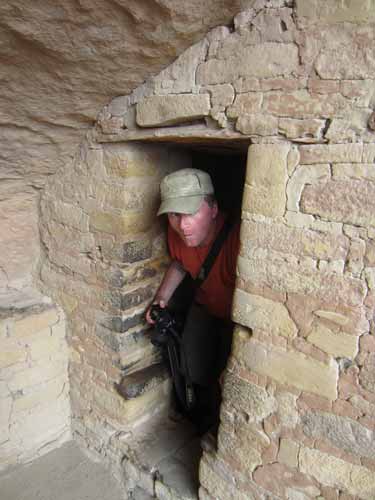
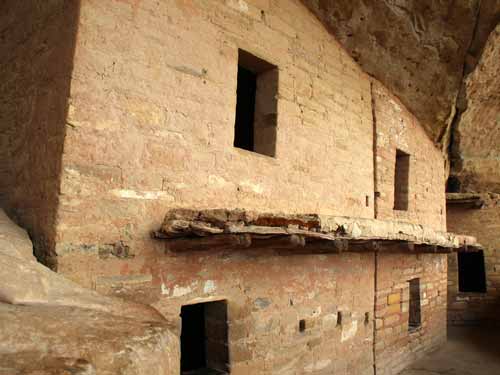
This ledge contains juniper bark, along with the regular wood and mortar.

Juniper bark can be seen on the right (the red stuff sitting on the wood beam).



Moving onto the next section of the dwelling
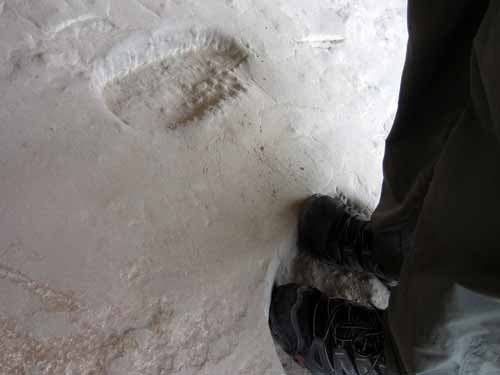
Using the toe hold trail
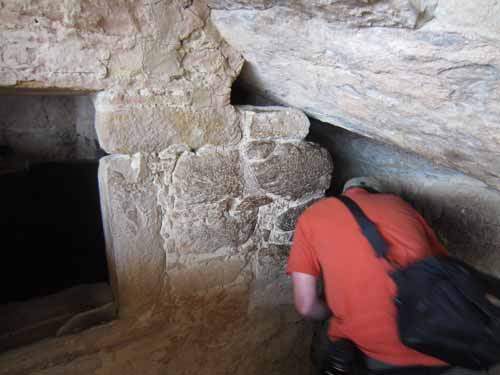
A narrow fit along the back wall


This next section contained the two kivas. This is the only area that did have some evidence of fire on the ceiling.


This is the center building that faces the solstice...

... with its T-doorway.

The mysterious markings on a wall that faces the La Plata Mountains



Stones for grinding corn. Corn was 70 - 80% of their diet. They did also have beans, squash, and yucca.
People not only had family roles, they also had community ones. There was a lot of specialization taking place... weavers, potters, craftsmen, clan leaders, etc. Impressively, there were 8 other communities living within 300 feet of here.

The far end of the dwelling
The way out was by crawling through a narrow tunnel. This was not part of the original building. It's not sure when they all left (sometime around 1280), but this seems to have been built several years after that.


A large rock sat mysteriously right in the center of the tunnel.

We then faced a VERY tall ladder, some stone steps, one final ladder... and then we were back on the mesa top!


I was SO grateful for the chain fence! It was quite a ways down.
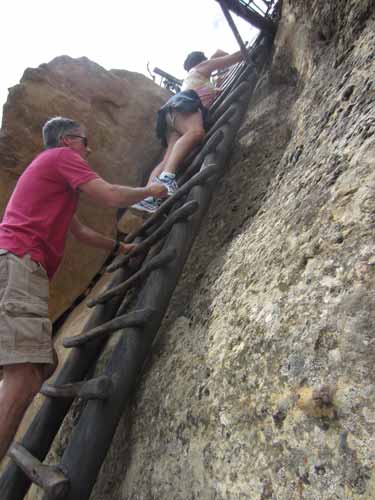
Almost there...

... and a final sigh of relief!
We had some lunch in the car of bread and cheese... no corn! It started to sprinkle a bit so we drove to the nearby Chapin Mesa Archeological Museum. We watched a movie and learned more about dear ol' Gustaf and his taking of hundreds upon hundreds of artifacts, as well as how freezing water is what helped create these alcoves in the soft sandstone.

The park headquarters buildings which contain the musem, from 1922 - 1938, are done in the Modified Pueblo Revival style.

The amazing dioramas are the work for the Civilian Conservation Corp in the 1930's. Each one is based on a real-life location. Before work began, sketches and a small scale replica was built. Each one then took hundreds of hours to complete, with every details crafted by hand. The goal was to incorporate everyday situations... work, play, laziness, and even some humor.
All lot of it was done just on trial and error. For example, to make the tiny realistic baskets, fabric was pressed into damp papier-mache to make a woven impression and then painted. For the alcoves, newspaper was soaked in water for several weeks. The paper was then put though a meat-grinder and mixed with plaster of Paris.
I'll go over all the history again... because it really starts to make more sense with the visuals.
10,000 to 15,000 years ago - Early habitation in North America. People began crossing the Bering Strait from Asia at least 15,000 years ago. The moved south, hunting elephants, mammoths camels and the Folsom bison (a larger version of today)... all now extinct. Based on a site near Folsom, New Mexico, this shows a group of hunter-gatherers moving in on some bison as they drink near a watering hole. No evidence of habitation has yet been found at Mesa Verde dating back this far.

1600 years ago - The Basketmaker Period. This shows a group of hunter-gatherers that have settled in the Four Corners area around A.D. 1 to 500. They used the many alcoves for sleeping and shelter. The introduction of agriculture allowed them to grow small crops and remain in one place rather than keep migrating with the seasons. Pottery had not yet been developed so weaving was very important.... hence the name of this period. Clothing was made from animal skins. Sandals of yucca fiber, belts woven from dog hair, and blankets from cordage and rabbit fur were popular. They were still hunting with spears and small snares.





1300 years ago - The Modified Basketmaker Period. Between 500 - 750, people began living in this area. This is a model of the Step House.They were still the Basketmakers but were now more dependent on agriculture. They also began to built permanent semi-subterranean houses known as pithouses... both in the alcoves and on the mesa top. They learned to make pottery as well as the bow and arrow. Weaving continued to be an important skill, and they started to raise turkeys.

It actually does look familiar... with the stone stairway and nearby pithouses!


Such great detail!

1200 years ago - The Developmental Pueblo Period. From 750 to 1100, the pueblo came onto the scene and individual houses all but disappeared. This is a sample village from 850. New techniques for farming were developed (such as the use of reservoirs and check dams) and trade became significant. The use of the T-shaped doors also showed up (exchange of architectural ideas). Potters experimented with different shapes and decorations. Geometric patterns emerged. Apparently this is also the time when head deformation became common in infants from using hard cradleboards.




The back of the infant's head would be completely flat.
800 years ago - The Classic Pueblo Period. 1100 to 1300 was the peak of this building style in the Mesa Verde area. But it wasn't special. This kind of stuff was happening all over the southwest. This is a model of the Spruce Tree House on an autumn day in the late 1200's. People moved from the mesa tops into large villages in the natural alcoves. In good years, farming would result in a surplus that they could store for future use. Trade linked them to other villages hundreds of miles away. They got cotton from Arizona, turquoise from New Mexico, and shells from the Pacific.


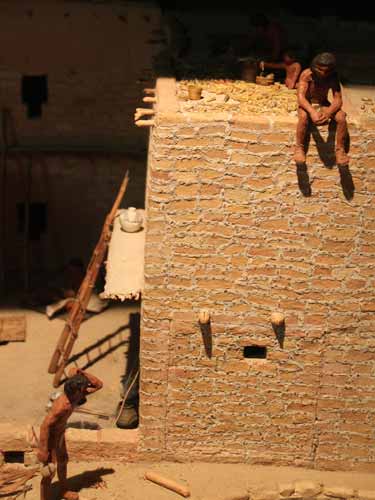
We then moved on to the many other displays and artwork.

The discovery of Table Mesa






Cute!... a bear being chased away by skunks.

